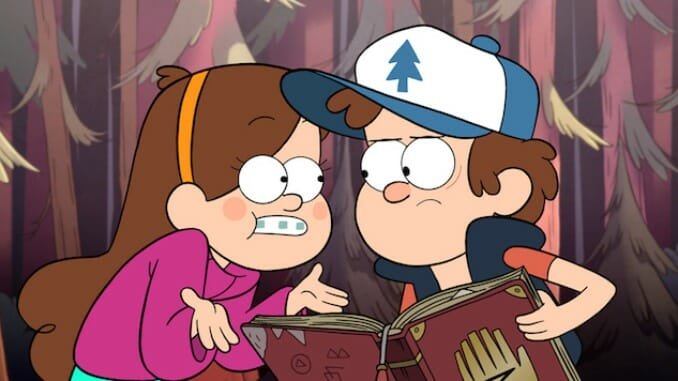Gravity Falls Made Gross, Exuberant Weirdness a Disney Channel Institution
Photo courtesy of Disney
The phrase “Disney cartoon” conjures up a lot of images: a cheerful, red-shorted mouse whistling his way down the street. A pale, dark-haired princess sleeping in a metaphor-laden glass box. A weirdly hot princeling lion bounding through a swaying jungle. A pale, white-haired princess belting out her loneliness from the top of a metaphor-laden glacier. Happily ever afters? That’s a Disney cartoon. Wholesome family bonding? That’s a Disney cartoon. Hard-but-adorably-merchandisable lessons about growing up? That, maybe more than anything else, is a Disney cartoon!
But cryptid hunting? Supernatural conspiracy mapping? Grifter geezers? Cosmic (and/or demonic) body horror? Were you to go out and survey a hundred random people you found on the street, you’d be hard-pressed to find even one person offering up images like those when prompted to describe what they think of when they think of a “Disney cartoon.”
And yet, since Gravity Falls debuted on the Disney Channel ten years ago, delivering tweenage twins Dipper and Mabel Pines (Jason Ritter and Kristen Schaal, respectively) to their con artist great uncle’s (Alex Hirsch) tourist trap doorstep in the paranormally active forest just outside Gravity Falls, Oregon, every one of those things has become a legit Disney cartoon staple. What’s more, so has the series’ signature long-game storytelling, exuberantly weird characterization, and gleeful willingness to just be gross. When you queue up a Disney Animated Original Series on your Disney+ app these days, you’re as likely to find a chaos-demon protagonist making a witchy, bone-chomping, anarchist flim-flam artist their mentor as you are to find a quirky, palatably rebellious modern Disney princess racing off to have adventures in between made-for-TV musical numbers—and it’s all thanks to those weirdo tweenage twins chasing Bigfoot and investigating cosmic mysteries out in the fictionally paranormal woods of cartoonist Alex Hirsch’s chaotic imagination.
Before we get to the self-segmenting grifter witches of Disney Channel today, though, let’s back up. While many of us have been excitedly keeping up with Disney’s linear spiral into deeply unsettling, frequently occult, existential weirdness since Gravity Falls took its final bow, there still exists a segment of the animation-loving populace that only has a passing familiarity with Hirsch’s short-lived mystery series at all, nevermind the enormous (and enormously weird) animated swings that have become its Disney Channel legacy. To those folks I say, give this primer from Paste editor Garrett Martin a quick scan. If you aren’t swayed by his description of Gravity Falls—which only lasted two seasons (36 episodes) before ceding the multidimensionally chaotic floor to the battles for good in the face of monster genocides, amphibian wars, and demonic fascism that would soon follow—as a “short-lived beauty [that] summons up thoughts of BoJack Horseman, Bob’s Burgers, Adventure Time, and Rick and Morty, not to mention live-action inspirations such as Twin Peaks, The X-Files, and Lost,” then there’s unlikely to be much for you here in the rest of this retrospective.
For everyone else, though, I invite you to take Garrett’s summation of Gravity Falls’ legacy as stemming from “its emphasis on familial relationships both healthy and broken, its heady admixture of sci-fi, horror, humorous pop culture references and profound emotion, even its central, ever-looming truth (Summer ends)” as something like gospel. I mean, Disney Channel certainly did: where Hirsch laid the groundwork for shaggy animated worlds constructed of of ideologically gray complexity and endless paranormal impossibility, creators like Daron Nefcy (Star vs. the Forces of Evil), Matt Braly (Amphibia), and Dana Terrace (The Owl House) built palaces of skulls, tadpoles, and laser-puppies. Where Hirsch made space for nuanced storytelling about found family, queer-coded and otherwise, Nefcy, Braly, and Terrace (among others) filled it with the kinds of relationships kids who grew up on a frustrated diet of Kim Possible v. Shego could hardly have dreamed of. And where Hirsch said, Yeah! Sure! Let’s give these kids a stable of believably oddball and/or emotionally damaged adults with whom to empathize over extremely adult problems! his future colleagues said, GREAT; HERE YOU GO.